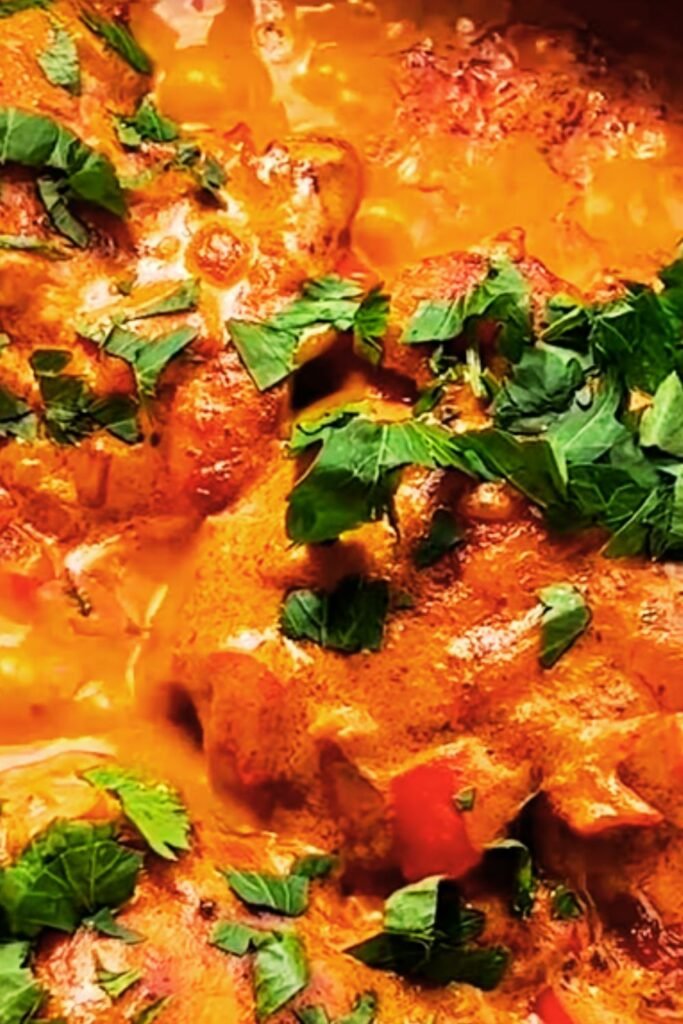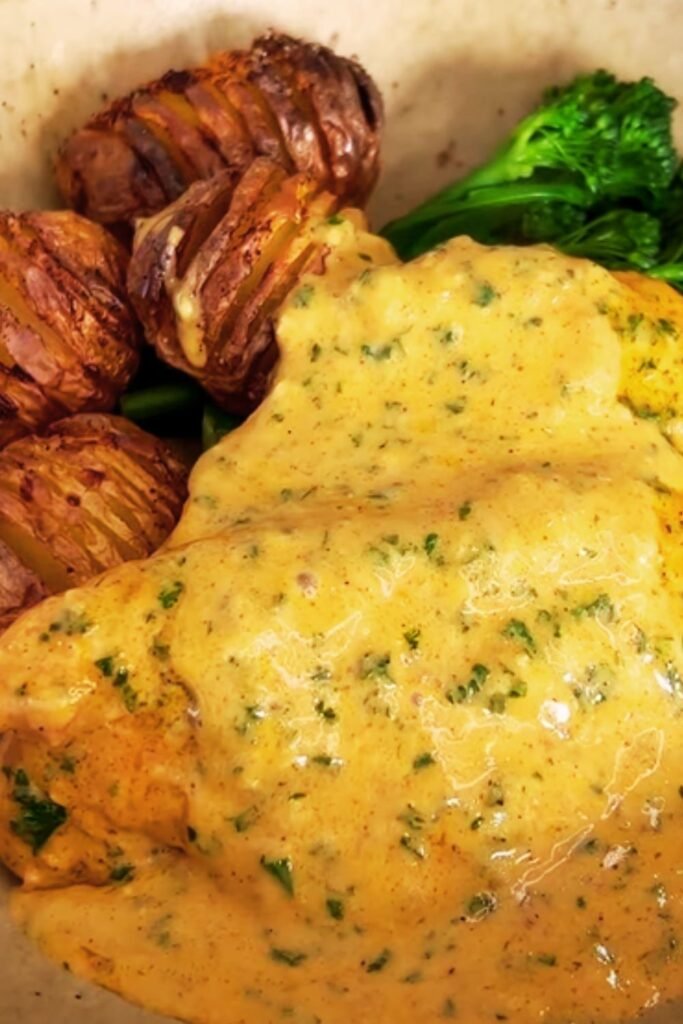There’s something magical about dishes that have stood the test of time, passed down through generations while maintaining their soul and character. Hungarian Chicken Paprikash (Paprikás Csirke) is precisely one of those treasures—a dish I first experienced during a culinary tour through Eastern Europe that forever changed my perspective on comfort food.
As I stood in a small Budapest kitchen, watching an elderly woman named Magda transform simple ingredients into something extraordinary, I knew this dish would become part of my culinary repertoire. The rich, velvety sauce, tender chicken, and aromatic paprika created a symphony of flavors that seemed to tell stories of Hungarian history and tradition with every bite.
Today, I’m thrilled to share not just a recipe, but a complete guide to mastering this Hungarian classic. Whether you’re a seasoned cook or a curious beginner, this article will walk you through everything you need to know about creating authentic Chicken Paprikash while offering modern variations to suit different dietary needs and preferences.
The Rich History Behind Chicken Paprikash
Chicken Paprikash emerged as a staple in Hungarian cuisine during the late 19th century, when paprika became Hungary’s national spice. The dish represents the perfect marriage between the humble chicken—available to most households regardless of economic status—and the distinctive sweet-yet-spicy paprika that gives Hungarian cuisine its characteristic flavor profile.
Originally a rustic peasant dish, Paprikash gradually found its way into high-end restaurants and international recognition. What makes this evolution fascinating is how the dish maintained its essential character while adapting to changing times. During my conversations with Hungarian home cooks, I discovered that nearly every family has their own slight variation, proving that this dish is truly a living tradition.
The word “paprikás” refers to the generous use of paprika, while “csirke” simply means chicken. Together, they form a dish that has become synonymous with Hungarian hospitality and culinary excellence.
Understanding Hungarian Paprika: The Soul of the Dish
Before we dive into the recipe, it’s crucial to understand that paprika isn’t just a sprinkle of red dust for color—it’s the fundamental character of this dish. During my culinary adventures, I’ve discovered that many cooking failures stem from using the wrong type of paprika or not understanding its nuances.
Hungarian paprika comes in eight grades of quality and spiciness:
- Különleges: Special quality, mildest, brightest red
- Édesnemes: Noble sweet, slightly pungent, most commonly exported
- Félédes: Semi-sweet, medium pungency
- Csípősmentes Csemege: Delicate, mild flavor
- Csemege Paprika: Exquisite delicate, more pungent
- Csípős Csemege: Delicate, yet pungent
- Rózsa: Rose paprika, strong aroma and medium pungency
- Erős: Strong, hottest variety
For authentic Chicken Paprikash, I recommend édesnemes (noble sweet) paprika. The flavor should be prominent but not overwhelmingly spicy. Remember that Hungarian paprika differs significantly from Spanish varieties and generic supermarket options labeled simply as “paprika.”
When I visited the Central Market Hall in Budapest, I was astonished by the variety of paprika available—vibrant red powders filling stall after stall with their distinctive aroma. I purchased several varieties and discovered that fresh, high-quality paprika makes an enormous difference in the final dish.

Essential Equipment for Perfect Paprikash
Before diving into the recipe, let’s ensure you have the right tools. While Chicken Paprikash doesn’t require specialized equipment, certain items will make your cooking experience more authentic and efficient:
- Heavy-bottomed Dutch oven or deep skillet: Provides even heat distribution and prevents the sauce from scorching.
- Wooden spoon: Traditional and practical for stirring without scratching your cookware.
- Sharp knife: For properly breaking down the chicken.
- Small whisk: Helpful when incorporating the sour cream to prevent lumps.
- Spätzle maker (optional): If you want to make traditional nokedli (Hungarian dumplings) to serve with your Paprikash.
I’ve prepared this dish in various kitchens with minimal equipment, so don’t worry if you don’t have specialized tools. The essence of Hungarian cooking lies in technique and quality ingredients rather than fancy gadgets.
Traditional Hungarian Chicken Paprikash Recipe
Let me share my carefully refined recipe that balances authenticity with accessibility. I’ve tested this countless times, making adjustments based on feedback from both Hungarian natives and novice cooks.
Ingredients
For the Chicken Paprikash:
- 3-4 pounds (1.5-2 kg) chicken pieces (traditionally a whole chicken cut up, with bone and skin)
- 2 large onions, finely diced (about 2 cups)
- 3 tablespoons authentic Hungarian sweet paprika
- 2 tablespoons lard or butter (traditional) or vegetable oil (modern alternative)
- 2 cloves garlic, minced
- 1 ripe tomato, diced
- 1 Hungarian wax pepper or bell pepper, seeded and diced
- 1 cup chicken broth
- 1 cup sour cream (room temperature)
- 2 tablespoons all-purpose flour
- Salt and freshly ground black pepper to taste
- 2 tablespoons fresh parsley, chopped (for garnish)
For the Optional Nokedli (Hungarian Dumplings):
- 2 cups all-purpose flour
- 3 large eggs
- 1/2 cup water
- 1 teaspoon salt
- 1 tablespoon butter (for finishing)
Preparation Method
Step 1: Prepare the Chicken
- Pat the chicken pieces dry with paper towels.
- Season generously with salt and freshly ground black pepper on all sides.
- Let the chicken rest at room temperature for 15-20 minutes to absorb the seasoning.
Step 2: Prepare the Base
- Heat the lard (or butter or oil) in a large Dutch oven or deep skillet over medium heat.
- Add the finely diced onions and a pinch of salt. Cook slowly for 8-10 minutes until translucent and very soft but not browned. Patience here is crucial—properly sweated onions form the foundation of the sauce.
- Add the minced garlic and cook for another minute until fragrant.
Step 3: Add the Paprika
- Remove the pot from heat (this is crucial to prevent burning the paprika).
- Immediately add the paprika and stir quickly to coat the onions evenly.
- Return to low heat and add the diced tomato and pepper. Stir to combine.
Step 4: Cook the Chicken
- Add the seasoned chicken pieces to the pot, skin side down first.
- Pour in enough chicken broth to come about halfway up the chicken (not completely covering it).
- Bring to a gentle simmer, then reduce heat to low.
- Cover and cook for about 45 minutes for dark meat or 30 minutes for white meat, turning halfway through, until the chicken is tender and cooked through.
Step 5: Prepare the Creamy Finish
- In a medium bowl, whisk together the sour cream and flour until smooth.
- Temper the mixture by slowly adding about 1/2 cup of the hot cooking liquid from the pot, whisking constantly.
- Pour the tempered sour cream mixture back into the pot, stirring gently to incorporate.
- Simmer (never boil) for another 5-10 minutes until the sauce thickens slightly.
- Taste and adjust seasoning with salt and pepper as needed.
Step 6: Prepare Nokedli (If Using)
- In a large bowl, mix flour and salt.
- Make a well in the center and add the eggs.
- Begin mixing while gradually adding water until you achieve a sticky, soft dough that slowly drops off a spoon.
- Bring a large pot of salted water to a boil.
- Using a spätzle maker or the back of a perforated spoon, push small portions of dough directly into the boiling water.
- Cook for 2-3 minutes until the dumplings float to the surface.
- Drain well and toss with a tablespoon of butter.
Step 7: Serve
- Place the chicken pieces on a serving platter or individual plates.
- Spoon the rich paprika sauce generously over the chicken.
- Serve with nokedli or another suitable side dish (see serving suggestions below).
- Garnish with fresh chopped parsley.

Common Mistakes and How to Avoid Them
During my journey to perfect this recipe, I’ve made nearly every possible mistake. Let me save you the trouble by highlighting the most common pitfalls:
| Mistake | Consequence | How to Avoid |
|---|---|---|
| Burning the paprika | Bitter, unpleasant taste that ruins the entire dish | Always remove the pot from heat before adding paprika, then return to low heat |
| Boiling the sauce after adding sour cream | Curdled, grainy sauce | Keep heat low and never let the sauce boil after adding dairy |
| Using old or low-quality paprika | Bland, colorful but flavorless dish | Invest in fresh, authentic Hungarian paprika and store in a cool, dark place |
| Skimping on onions | Thin, less flavorful sauce | Use plenty of onions and cook them slowly and thoroughly |
| Rushing the cooking process | Tough chicken and underdeveloped flavors | Allow time for slow simmering to develop rich flavors |
| Adding too much liquid | Diluted flavors and thin sauce | Add just enough broth to partially cover the chicken |
| Using cold sour cream directly | Lumpy sauce with curdled dairy | Always temper sour cream with hot cooking liquid before adding to the pot |
Regional Variations and Family Secrets
What fascinates me about Chicken Paprikash is how it varies across Hungary’s regions and family traditions. Here are some authentic variations I’ve encountered:
Eastern Hungarian Version
In eastern Hungary, particularly around Debrecen, cooks often add a small amount of smoked paprika alongside the sweet variety. This creates a deeper, more complex flavor profile that pairs beautifully with the region’s robust red wines.
Budapest Metropolitan Style
In Budapest’s restaurants, I noticed chefs frequently add a splash of white wine to the sauce before simmering. This subtle acidity balances the richness of the dish and adds complexity to the flavor profile.
Southern Hungarian Version
In southern regions bordering Serbia, cooks often incorporate more heat with the addition of hot paprika or fresh chili peppers, creating a more robust and spicy variation.
Family Secret: Lemon Zest
One elderly Hungarian grandmother shared her family’s secret with me: adding a small amount of fresh lemon zest just before serving. She whispered that this brightens the entire dish without altering its authentic character. I’ve since incorporated this technique and can confirm it’s a game-changer.
Modern Dietary Adaptations
While I’m a purist at heart, I recognize the need for adaptations to accommodate various dietary restrictions. Here’s how to modify this classic dish without losing its essence:
Dairy-Free Version
Replace sour cream with coconut cream mixed with a tablespoon of lemon juice. While not traditional, it maintains the creamy texture and tangy flavor profile.
Gluten-Free Adaptation
Substitute all-purpose flour with rice flour or cornstarch for thickening. For the nokedli, use a gluten-free flour blend with a pinch of xanthan gum for proper texture.
Lighter Version
Use skinless chicken breast or thighs, Greek yogurt instead of sour cream, and olive oil instead of lard. While purists might object, this version reduces calories while maintaining good flavor.
Vegetarian Option
Replace chicken with chunky pieces of cauliflower, mushrooms, and chickpeas for a hearty meatless alternative that still captures the essence of the dish.
Serving Suggestions and Accompaniments
Traditionally, Chicken Paprikash is served with nokedli (Hungarian dumplings), but there are several excellent alternatives depending on your preference and what you have available:
- Buttered egg noodles: A quick and accessible alternative to homemade nokedli
- Boiled potatoes: Simple but effective for soaking up the delicious sauce
- Rice: Not traditional but works well, especially a short-grain variety
- Crusty bread: Perfect for an informal meal where sauce-sopping is encouraged
- Cucumber salad: A traditional accompaniment that provides refreshing contrast
- Pickled vegetables: The acidity cuts through the rich sauce beautifully
I personally prefer serving Paprikash with a side of simple pickled cucumbers dressed with vinegar, a touch of sugar, and fresh dill—the bright acidity provides perfect contrast to the rich, creamy sauce.

Storage and Reheating Tips
One of the wonderful aspects of Chicken Paprikash is that it often tastes even better the next day, after the flavors have had time to meld. Here’s how to properly store and reheat this dish:
Storage
- Refrigeration: Store in an airtight container for up to 3 days.
- Freezing: Freeze without the sour cream element, then add fresh sour cream when reheating. Can be frozen for up to 3 months.
Reheating
- Stovetop: Reheat gently over low heat, stirring occasionally. If the sauce has thickened too much, add a splash of chicken broth.
- Microwave: Use medium power and stop to stir halfway through to ensure even heating.
- Oven: Place in an oven-safe dish, cover with foil, and heat at 325°F (165°C) until warm throughout.
Important Note
Never bring leftover Paprikash to a boil when reheating, as this can cause the sauce to separate and become grainy.
Frequently Asked Questions
Q: Can I use smoked paprika instead of sweet Hungarian paprika?
While authentic Chicken Paprikash uses sweet Hungarian paprika, you can substitute a small portion (about 1/4 of the total amount) with smoked paprika for a modern twist. However, using only smoked paprika would significantly alter the traditional flavor profile.
Q: My sauce curdled after adding the sour cream. Can I fix it?
Curdling typically happens when the sauce is too hot or comes to a boil after adding sour cream. You can sometimes rescue it by removing from heat immediately and whisking in a tablespoon of flour mixed with cold water. In the future, ensure you properly temper the sour cream and keep the heat very low.
Q: Is it better to use bone-in or boneless chicken?
Traditional Paprikash uses bone-in, skin-on chicken pieces as they provide more flavor and moisture. However, boneless pieces work fine if you prefer easier eating. Just reduce the cooking time by about 10-15 minutes and be careful not to overcook.
Q: Can I make this dish in advance for a dinner party?
Absolutely! In fact, Paprikash often tastes better when made a day ahead. Prepare the entire dish minus the final sour cream addition, then reheat gently and add the sour cream mixture just before serving.
Q: What can I substitute for nokedli if I don’t have time to make them?
Store-bought egg noodles are the closest substitute. Cook them just shy of al dente, then finish them in the sauce for the last few minutes of cooking.
Q: Why is my paprika sauce bitter?
Bitterness almost always comes from burned paprika. Remember to take the pot off the heat before adding paprika, stir quickly to incorporate, then return to low heat. Paprika burns very easily and becomes bitter when exposed to high heat directly.
Q: Can I make this in a slow cooker or Instant Pot?
Yes! For slow cooker: Follow steps for sautéing onions and adding paprika, then transfer to slow cooker with chicken and broth. Cook on low for 6 hours. Add the tempered sour cream during the last 30 minutes.
For Instant Pot: Use the sauté function for the initial steps, then pressure cook on high for 10 minutes (for dark meat) with natural release. Add tempered sour cream after pressure cooking is complete.
Final Thoughts on Mastering Hungarian Chicken Paprikash
The beauty of Chicken Paprikash lies in its beautiful balance of simplicity and depth. While the ingredient list is relatively short, the technique and quality of ingredients make all the difference between a good dish and an exceptional one.
As I’ve shared this recipe with friends and family over the years, I’ve watched them develop the same appreciation for Hungarian cuisine that I gained during my travels. There’s something truly special about cooking a dish that has sustained generations of families through both hardship and celebration.
Remember that authentic cooking is as much about respect for tradition as it is about the joy of sharing food with others. When you serve Chicken Paprikash, you’re not just offering a meal—you’re sharing a piece of Hungarian cultural heritage, a story told through flavor that spans centuries.
Whether you follow the recipe exactly as written or incorporate some of the variations to suit your dietary needs or pantry ingredients, I hope this dish brings as much comfort and pleasure to your table as it has to mine.